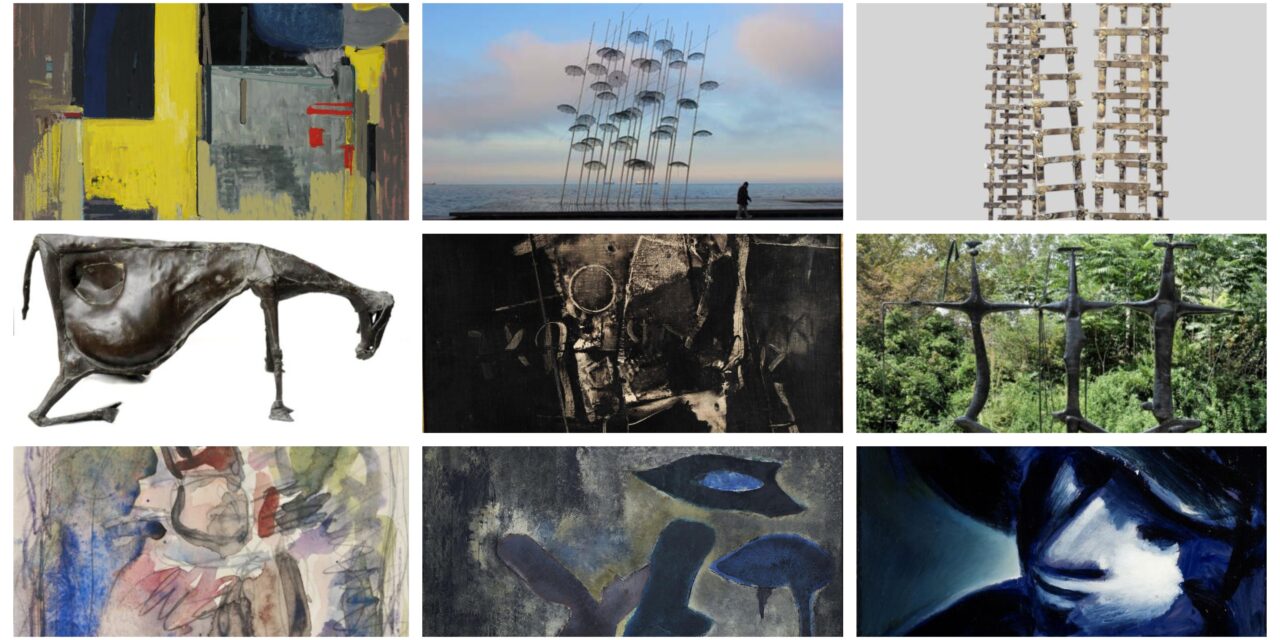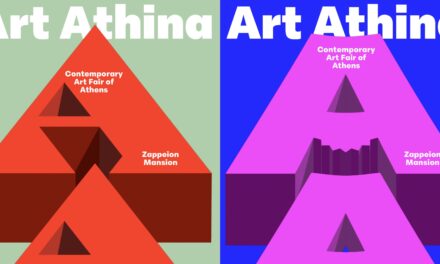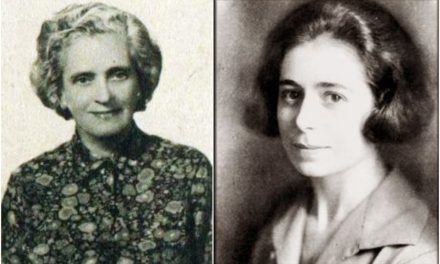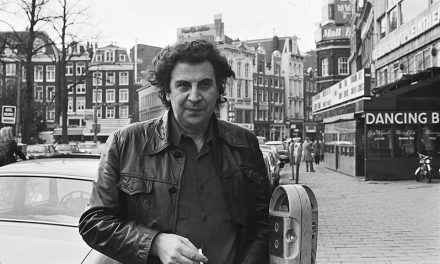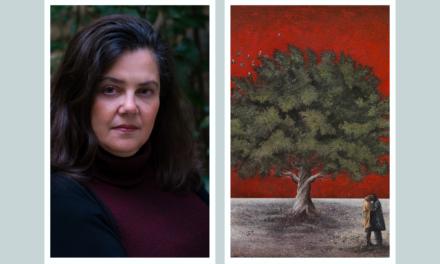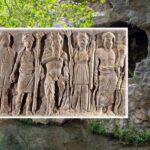Modernism in Greek visual arts has been a dynamic and evolving field throughout the 20th century, shaped by the country’s rich cultural heritage, political changes, global influences and the advent of new media and technology. It is characterized by the exploration of abstraction, experimental techniques, and the use of modern materials, offering a fascinating glimpse into the complexities of Greek identity, history, tradition and modernity. Through a series of articles, Greek News Agenda presents a brief panorama of the Greek visual art scene in the second half of the 20th century. The articles are based on the catalogue of the landmark exhibition at the National Gallery “Metamorphoses of the Modern – the Greek Experience”, curated by Dr. Anna Kafetsi (14.5-13.9.1992). The exhibition aimed to address the complex question: “Does a Greek modernism, in fact, exist? And if so, what is its character?” More than 100 Greek artists—both from the Greek metropolis and the Diaspora—were selected for their “autonomous plastic language” and featured in the exhibition . About 50 artists, key figures of the post-war Greek visual art scene, are explored in greater depth in the series.
Visual Arts in Greece: 1950s–1990s – Part 1/6: “From self-referentiality to the gesture”
(Source: Dr Anna Kafetsi, Catalogue of the exhibition “Metamorphoses of the Modern – the Greek Experience”, National Gallery, Athens, 1992, p. 99-100)
“In the more perfected works of the so-called “Generation of the 30s”, the representational function often went as far as to eliminate the real relationship of external things and its redefinition on the basis of the internal logic of the visual structure. Transformation of the real went still further in the new series of works (produced by a variety of abstractive practices) and, in a stage of transition which cannot be strictly redefined chronologically, tended to head to the direction of self-referentiality, in which the theme of painting is painting itself and its language […] In colour abstraction, where the colour rather than the line has priority, space is completely autonomous of any representational reduction and is produced out of the relationships between the various colour planes […] The emancipation of sculpture arrived along a number of paths and by means of a variety of techniques, new and old, and simultaneously experimentation with a range of materials […] Sculpture embarked on a fruitful dialogue with painting […] The generous contribution made by sculpture to Modernism began with the group of Greek artists who, after the 1950s, lived and worked permanently or for long periods in Paris and continued, thereafter, gaining in strength. At the same time, a fresh generation of painters moved on to the French capital after some of them had spent some time in Rome. Although they persisted in using the traditional frame, these painters pushed painting as a gesture in the direction of still greater autonomy […] The gesture […] shifted the entire significance of the work from the painting to the visual act […]”.
FEATURED ARTISTS (PART 1) : Spyropoulos, Zongolopoulos, Bouzianis, Kontopoulos, Kapralos, Sklavos, Aperghis, Stamos, Mylona, Christophorou
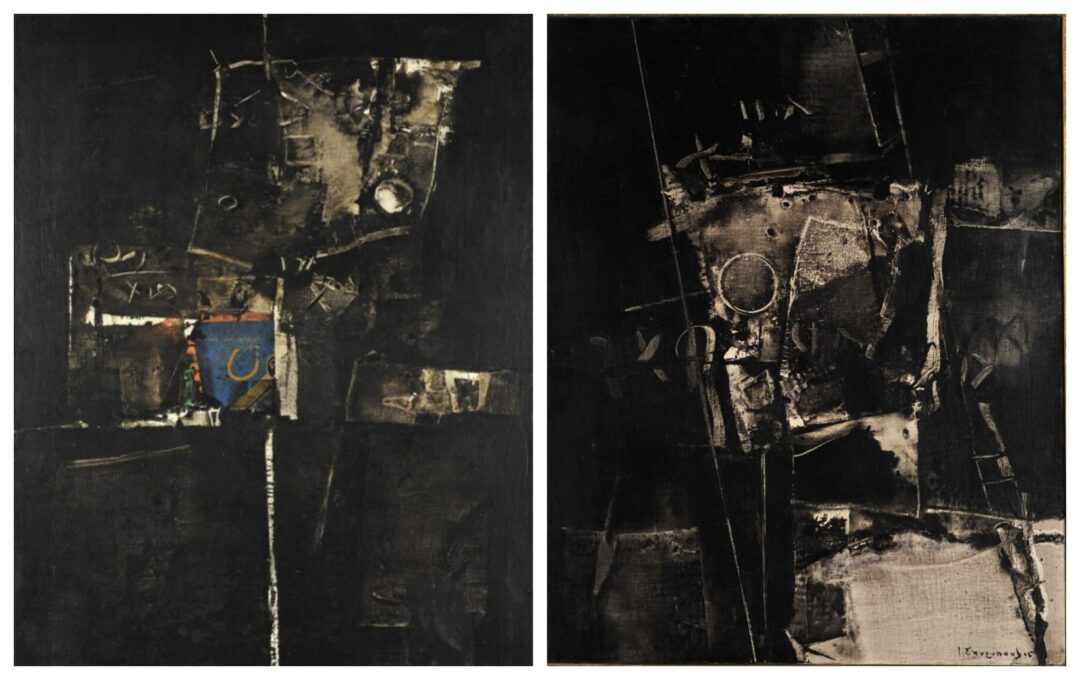
Yannis Spyropoulos, Phaos C, 1966, Mixed media on canvas, 128 x 96,5 cm, Athens National Gallery (left), All That Remained, 1973, Oil on canvas, 65 x 54 cm, Athens National Gallery (right)
YANNIS SPYROPOULOS (Pylos, 1912 – Athens, 1990) was a major representative of non-figurative art in Greece. He studied at the Athens School of Fine Arts (1933-38) and in Paris at the School of Fine Arts and at private schools (1938-40). “A Classicist of Abstraction”, Spyropoulos advanced his morphoplastic explorations, evolving from figurative to abstract art, and ultimately to pure abstraction. His gestural interventions and evocative use of colour create a personal style marked by an an intensely dramatic nature. Spyropoulos presented his works in solo, group and international exhibitions in Greece and abroad, including the Alexandria Biennale (1955), the São Paulo Biennale (1957), and Documenta in Kassel (1964, 1975).In 1960 he won the UNESCO Prize at the 30th Venice Biennale. In 1961 he won the Gold Medal of the City of Ostende in Belgium, in 1966 the Order of the Phoenix in Athens and in 1978 the Gottfried von Herder Prize in Vienna. In November 1990, the Jannis and Zoe Spyropoulos Foundation was formed. (Source: National Gallery of Athens)
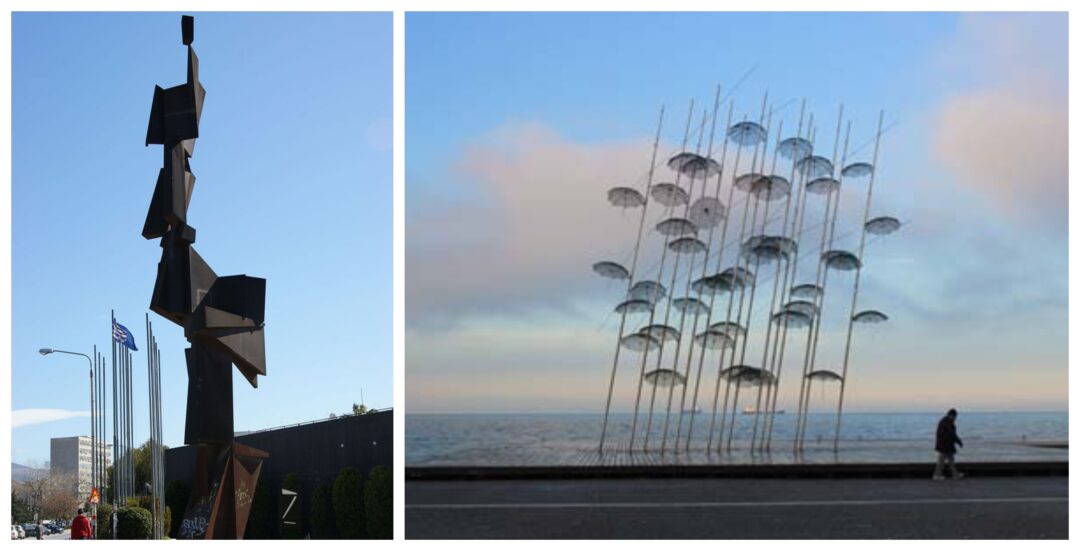
Giorgos Zongolopoulos , Cor-ten, 1966, 17m, Cor-ten steel, Sculpture at the entrance of the Thessaloniki International Fair (left), Umbrellas, 1997, New Waterfront of Thessaloniki – the work featured at the entrance to the 45th Venice Biennale in 1995 (right)
GIORGOS ZONGOLOPOULOS (Athens, 1903 – Athens, 2004) studied sculpture at the Athens School of Fine Arts (1924-1930). In 1949, he spent a year in Paris and later lived in Italy from 1953 to 1954. Since 1960, he shifted to abstraction, creating constructivist metal works. His materials progressively expanded to include combinations of nickel, glass, plexiglas, stainless metal, lenses, springs, nails, pipes, umbrellas, and beams. His art makes use of light and movement, and explores the relationship between positive and negative space, shapes and sounds, in an ongoing dialogue with space. His interest in integrating sculpture with the environment led to frequent collaborations with architects and awards for public site works. Zongolopoulos presented his works in many exhibitions, including the Venice Biennale (1940, 1956, 1964, 1993, 1995), the São Paulo Biennale (1957), and the Paris Salons. (Source: National Gallery of Athens)
Read also: Arts in Greece | George Zongolopoulos – the art of making space sculptures
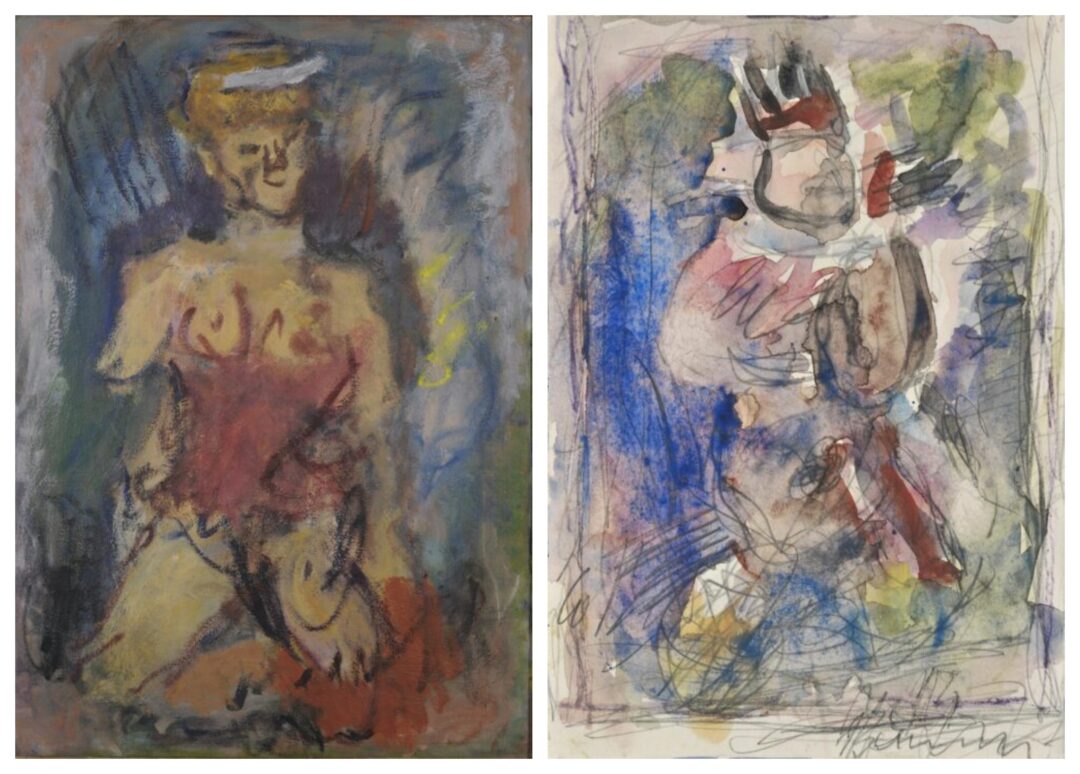
Giorgos Bouzianis, Actress, 1954, Oil on canvas, 105 x 75 cm, Athens National Gallery (left), Figure, ca. 1950, Watercolour and pencil on pasteboard, 20,3 x 13,5 cm, Athens National Gallery (right)
GIORGOS BOUZIANIS (Athens, 1885 – Athens, 1959) studied at the Athens School of Fine Arts (1897-1906) before moving to Germany, where he enrolled in the Munich Academy. The most important of the Greek expressionist painters, he developed his artistic style in Germany during the avant garde period. He was a member of the Neue Secession and Neue Gruppe. In 1935, he settled in Athens. Portraiture and the human figure were the central themes of his work, with color serving as a fundamental structural element and an autonomous value. His work becomes a vehicle for emotional states and foreshadows abstraction. Bouzianis participated in numerous exhibitions in Germany, and in the Venice Biennale (1950). In 1956, he won the Greek Prize in the international Guggenheim competition. (Source: National Gallery of Athens)
Read also: Arts in Greece | George Bouzianis, Greece’s forerunner of expressionism
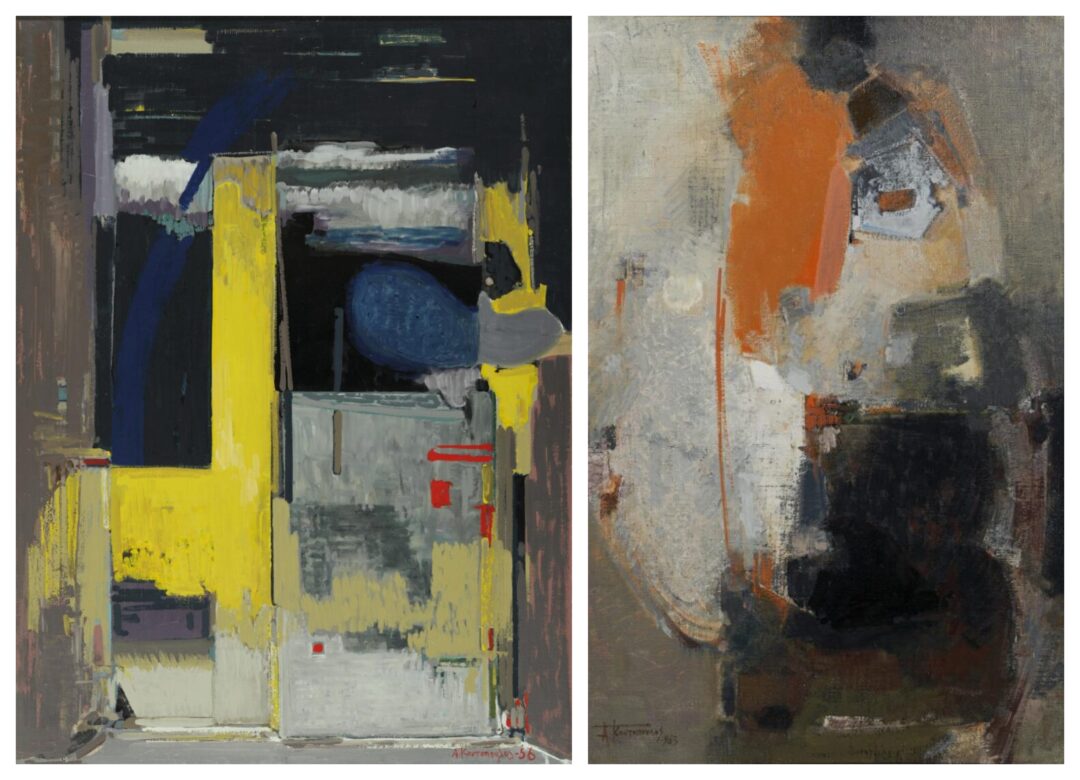
Alekos Kontopoulos, Night is Coming, 1956, Oil on canvas, 106 x 80 cm, Athens National Gallery (left), Composition, 1963, Oil on burlap, 122 x 80 cm, Athens National Gallery (right)
ALEKOS KONTOPOULOS (Lamia 1904 – Athens 1975) studied at the Athens School of Fine Arts (1923-29) and in Paris, where he became a member of the Paris-Montparnasse group in 1937. In 1939, he returned to Greece and was appointed to the National Archeological Museum. During the German occupation, he participated in the resistance, and in 1949 he founded, along with several colleagues, the group The Extremists. In the 50s, he turned to non-figurative art, becoming a pathfinder and contributing decisively to the spread of abstract art in Greece. He was also involved in book and magazine illustration, gave lectures, and published books. Kontopoulos presented his work in solo and group exhibitions in Greece and abroad, notably at the São Paulo Biennales (1953, 1955 winning the silver medal, and 1957), the Alexandria Biennale in 1959 and the Venice Biennale in 1960. (Source: National Gallery of Athens)
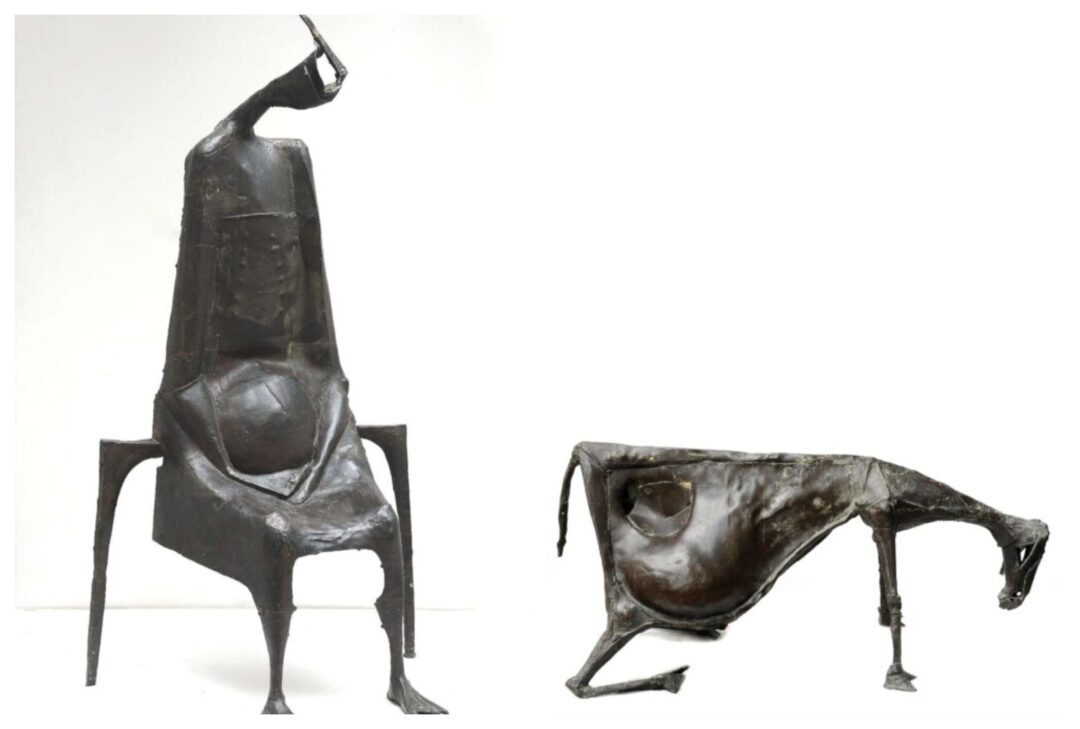
Christos Kapralos, Seated Mother, 1960, Bronze, 89 x 57 x 62 cm, Athens National Gallery (left), Goat, 1961, Bronze, 50 x 110 x 45 cm, Athens National Gallery (right)
CHRISTOS KAPRALOS (Panetolio, Agrinion, 1909 – Athens, 1993) studied painting at the Athens School of Fine Arts (1930-34) and sculpture in Paris. In 1940, with the outbreak of war, he returned to Greece. In 1946, he moved to Athens, and in 1962, he settled on the island of Aegina. His sculpture focused on the human figure, and in the early 1960s, he turned to abstract compositions, though not completely non-figurative. He was also interested in objects of everyday use and animal figures, and used wood to create compositions inspired by mythology, history and the Christian tradition. Kapralos presented his work in many exhibitions in Greece and abroad, including the Venice Biennale (1962, 1972) and the São Paulo Biennale (1975). Since 1995, his studio in Aegina functions as the Kapralos Museum (Source: National Gallery of Athens)
Read also: Yannis Moralis – Christos Kapralos: Friendship in Life and Art
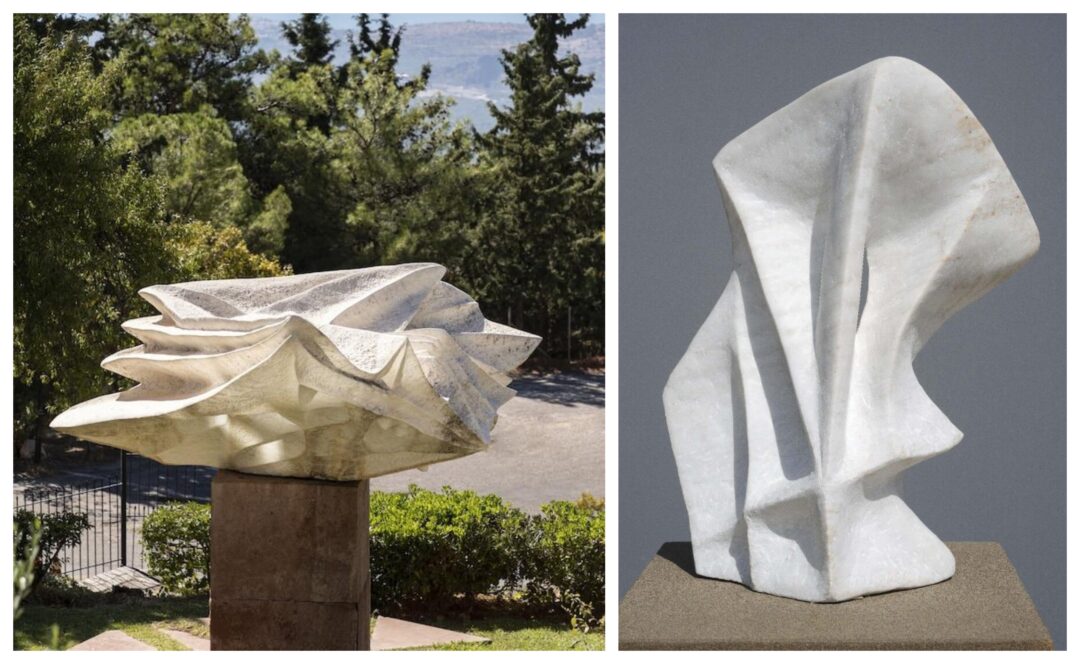
Yerassimos Sklavos, Delphic light, Pentelic marble, Amalia Hotel, Delphi, 1965-66 (left), Lightning, 1965, marble, 60 x 39 x 25cm, Athens National Gallery (right)
YERASSIMOS SKLAVOS (Domata, Kefalonia, 1927 – Levallois Perret, Paris, 1967) studied sculpture at the Athens School of Fine Arts and later continued his studies at the École des Beaux-Arts in Paris. After initially working with a figurative approach, he adopted abstraction in 1959. Primarily working with hard materials – granite, quartzite, marble, and porphyry – he created works mainly within the realms of geometric abstraction and organic abstraction. In 1960, he invented “Telesculpture”, a patented technique that allowed him to carve his materials more easily using an oxyacetylene flame. Light plays a fundamental role in the effectiveness of his work, revealing recesses and apertures while highlighting the volumes, surfaces, the nature and colours of his materials. His first solo exhibition took place in 1961 at Yvonne Zervos’s gallery, Cahiers d’Art in Paris, followed by many solo and group exhibitions during his lifetime and posthumously. (Source: National Gallery of Athens)
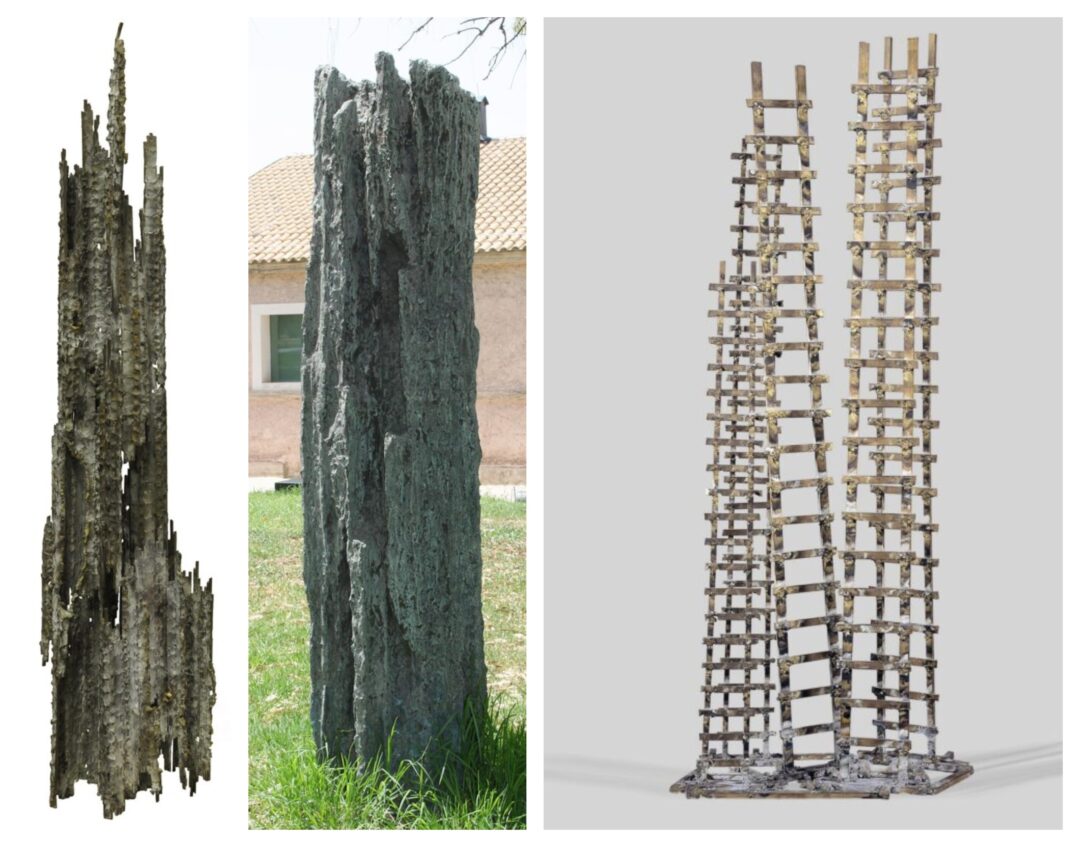
Achilleas Aperghis, Composition, 1963, Bronze, 99 x 20 x 19 cm, Athens National Gallery (left), Solitude, 1966, Bronze, 205 x 58 x 38 cm, National Glyptotheque (center), Ladders, [c. 1978], Bronze, 115,5 x 48 x 23,5 cm, Athens National Gallery (right)
ACHILLEAS APERGHIS (Garitsa, Corfu, 1909 – Athens, 1986) studied sculpture at the Athens School of Fine Arts (1937-39). After 1950, he turned towards more abstract forms, eventually moving toward complete abstraction. Until 1960 he created compositions using welded iron rods, close to Constructivism and Expressionism. Shifting from iron to bronze, he created works that resembled objects corroded by time. After a period of deep reflection and inertia, he continued his artistic explorations through environments and installations in the 1980s. Aperghis participated in many important exhibitions, including the Venice Biennale (1956, 1968), the São Paolo Biennale (1957) and the Alexandria Biennale (1957), repeated appearances at the Salon de la Jeune Sculpture in Paris, and the Europalia in Brussels in 1982. (Source: National Gallery of Athens)
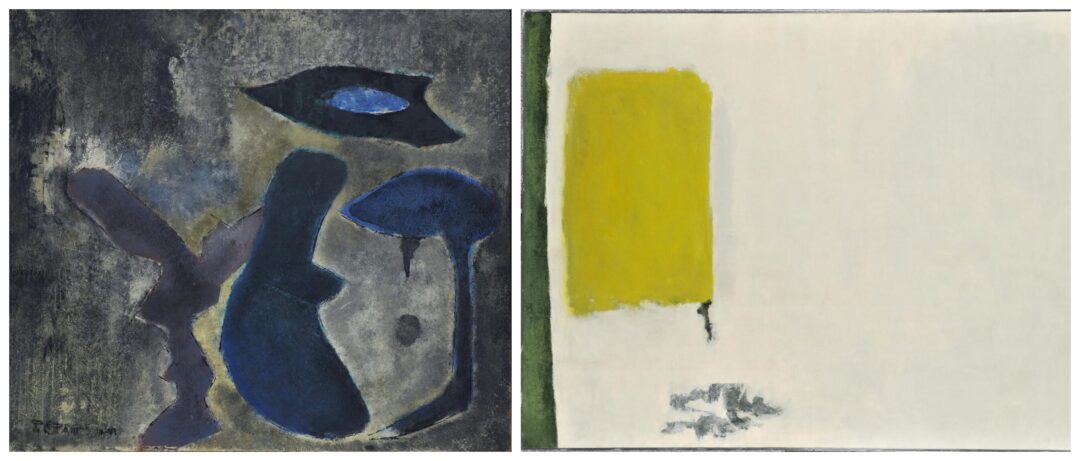
Theodoros Stamos (1922 – 1997), Archaic Building, 1946 – 1947, From the series “Biomorphicals Paintings”, 1945–1963, Oil on canvas, 50 x 60 cm, Athens National Gallery (left), Sun Box- Field, 1963 – 1964, From the series “The Sun – Boxes”, 1963–1970, Oil on canvas, 112 x 152 cm, Athens National Gallery (right)
THEODOROS STAMOS (New York, 1922 – Ioannina, 1997) was a leading figure in abstract expressionism internationally. A child of Greek immigrants, he took night lessons at the School of American Artists in New York (1936-1940). Throughout his life, he consistently moved ahead in the visual arts – from his biomorphic paintings (1945-1949) and abstract, calligraphic works (1949-1955) to the three large series he created from 1954 to 1993 – producing a spiritual work noted for its existential and ontological content. In 1966, he taught as a visiting professor at Columbia University. In 1970, Stamos began dividing his time between New York and his family’s homeland, the island of Lefkada. In 1958-59, his works were included in the important exhibition Modern American Painting at MoMA. Over the years, major American museums and modern art centers have acquired his works. (Source: National Gallery of Athens)
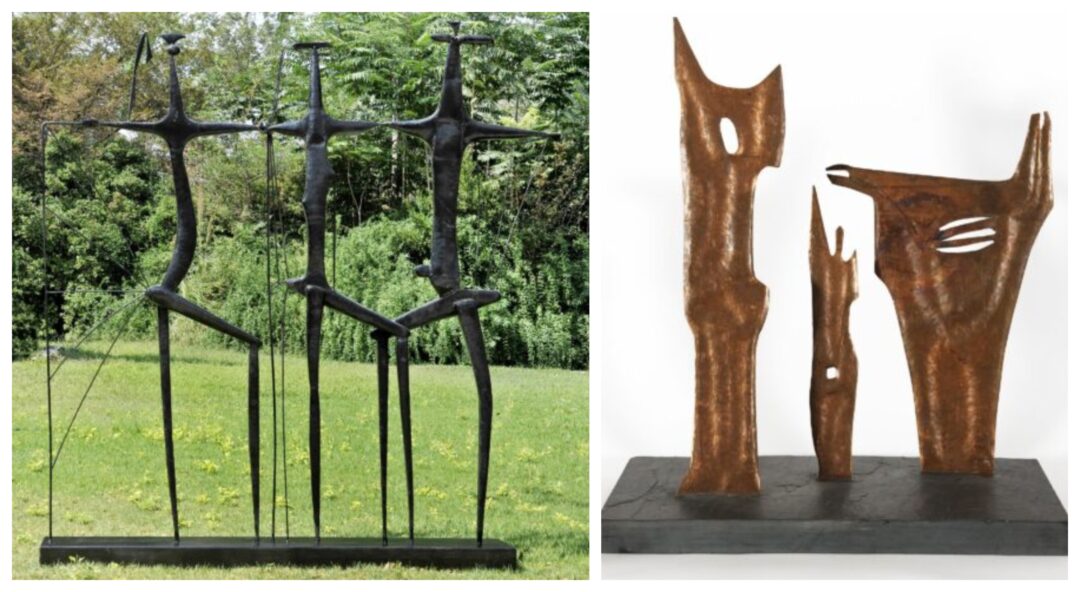
Alex Mylona, Berioshka, 1957, Hammered iron, 235 x 200 x 30 cm, Athens National Gallery (left), King-Queen, 1961, Hammered bronze, 43 x 35 x 9 cm, Athens National Gallery (right)
ALEX MYLONA (Athens, 1920 – Athens, 2016) studied sculpture at the Athens School of Fine Arts in 1945. Her move to Paris in the 1960s and her encounters with significant artists were transformative, shaping her artistic oeuvre. From her early anthropocentric compositions in the 1950s, she gradually moved towards abstraction, developping her own personal vocabulary. She created metal works distinguished by their expressionistic content and extreme angular appendages, highlighting the expressive possibilities of the material. Mylona was a founding member and vice chairman of the Association of Greek Women Artists. Her work has been presented in solo and major group exhibitions, including the Venice Biennale (1960), the São Paulo Biennale (1961), and the Montreal Biennale (1968). In 2014, the MOMus-Museum Alex Mylona was founded in Thissio, Athens. (Source: National Gallery of Athens)
Read also: Arts in Greece l Alex Mylona, a pioneer of the Greek modernist movement
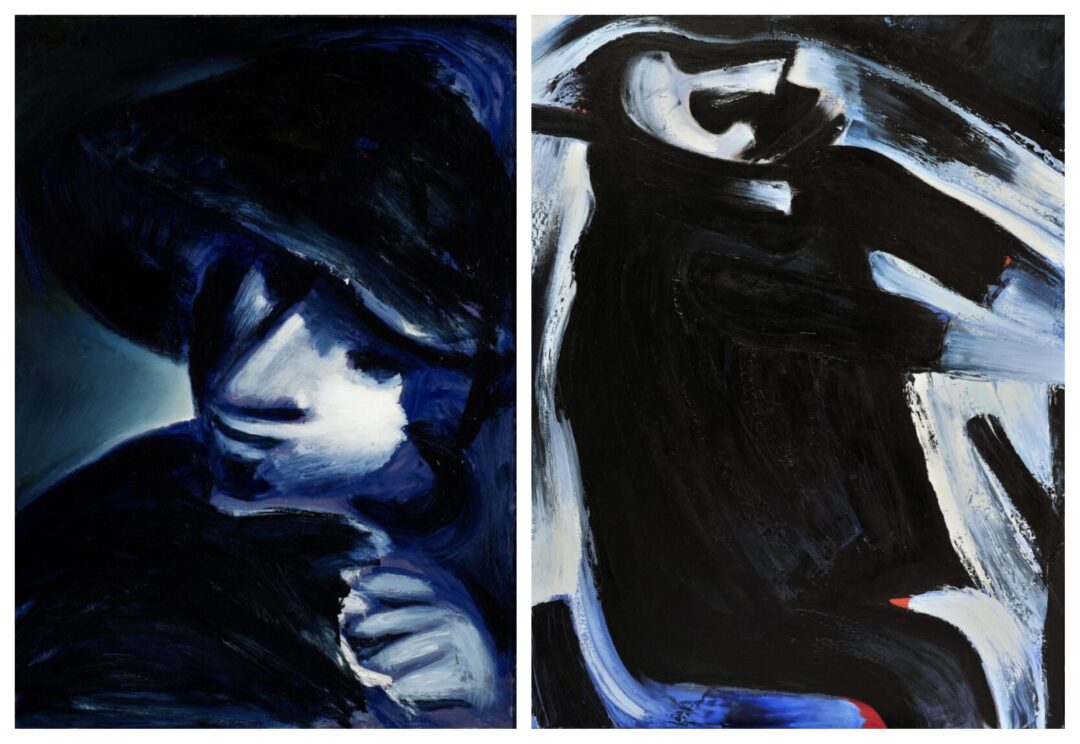
John Christoforou, Woman in Black, 1949 – 1952, Oil on pressed board, 87 x 67 cm, Athens National Gallery (left), Homme blesse, 1994, Oil on canvas, 116 x 146 cm, Athens National Gallery (right)
JOHN CHRISTOFOROU (London, 1921 – Paris, 2014) was the child of Greek immigrants from Smyrna. In 1935, he studied for a brief period at the Athens School of Fine Arts, and in 1938, he returned to England. In 1956 he settled in Paris. A forerunner of “New Figurative Painting”, he began creating figurative, expressionistic works in the early 1960s, using vibrant color and strong, black outlines, with the human figure and the drama of human existence at the forefront. In 1962, he took part in the exhibition New Figurative Painting and in 1965, won the AICA prize in London. He presented his work in numerous group, solo and retrospective exhibitions, including in Randers (Denmark, 1974), Saint-Étienne (1979), Montbéliard, Dunkirk, and Saint-Quentin (1986). (Source: National Gallery of Athens)
I.A.

